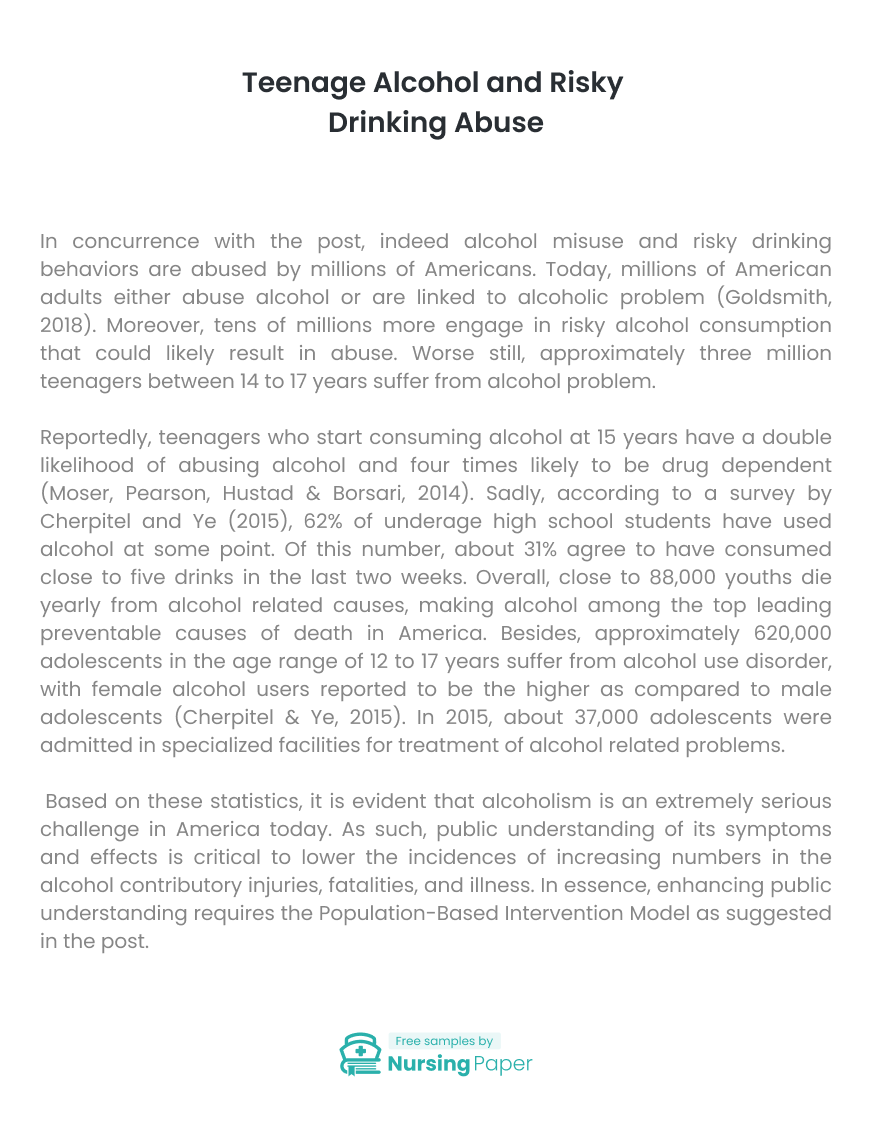
Teenage Alcohol and Risky Drinking Abuse
Introduction
In concurrence with the post, indeed alcohol misuse and risky drinking behaviors are abused by millions of Americans. Today, millions of American adults either abuse alcohol or are linked to alcoholic problem (Goldsmith, 2018). Moreover, tens of millions more engage in risky alcohol consumption that could likely result in abuse. Worse still, approximately three million teenagers between 14 to 17 years suffer from alcohol problem.
Reportedly, teenagers who start consuming alcohol at 15 years have a double likelihood of abusing alcohol and four times likely to be drug dependent (Moser, Pearson, Hustad & Borsari, 2014). Sadly, according to a survey by Cherpitel and Ye (2015), 62% of underage high school students have used alcohol at some point. Of this number, about 31% agree to have consumed close to five drinks in the last two weeks. Overall, close to 88,000 youths die yearly from alcohol related causes, making alcohol among the top leading preventable causes of death in America. Besides, approximately 620,000 adolescents in the age range of 12 to 17 years suffer from alcohol use disorder, with female alcohol users reported to be the higher as compared to male adolescents (Cherpitel & Ye, 2015). In 2015, about 37,000 adolescents were admitted in specialized facilities for treatment of alcohol related problems.


Based on these statistics, it is evident that alcoholism is an extremely serious challenge in America today. As such, public understanding of its symptoms and effects is critical to lower the incidences of increasing numbers in the alcohol contributory injuries, fatalities, and illness. In essence, enhancing public understanding requires the Population-Based Intervention Model as suggested in the post. Intrinsically, education on the effects of alcohol use can be an ideal way of potentially reducing the number of teenagers who are addicted to and are usually adversely affected by the drug. Similarly, as proposed in the post, one easy way to get to the group would be through classroom education. As an old adage goes, prevention is better than cure; as such, educating teenagers on the dangers of alcohol before they start thinking about drinking is effective.
From a personal experience, apart from alcohol abuse by the youths, there has been increasing cases of addiction and deaths from the abuse of prescription drugs in America, especially prescription opioids (Goldsmith, 2018). Therefore, future discussion should look into how prescription drugs have majorly contributed to addiction and drug abuse among the youths and how to solve the menace.
1. Cherpitel, C., & Ye, Y. (2015). Risky Drinking, Alcohol Use Disorders, and Health Services Utilization in the U.S. General Population: Data from the 2005 and 2010 National Alcohol Surveys. Alcoholism: Clinical and Experimental Research, 39(9), 1698-1704. doi: 10.1111/acer.12801
2. Goldsmith, C. (2018). Addiction and overdose: Confronting an American crisis. Minneapolis: Twenty-First Century Books.
3. Moser, K., Pearson, M., Hustad, J., & Borsari, B. (2014). Drinking games, tailgating, and pregaming: Precollege predictors of risky college drinking. The American Journal of Drug and Alcohol Abuse, 40(5), 367-373. doi: 10.3109/00952990.2014.936443



The download will start shortly.

The download will start shortly.
 Subject:
Nursing
Subject:
Nursing  Number of pages: 3
Number of pages: 3  Subject:
Medicine
Subject:
Medicine  Number of pages: 4
Number of pages: 4  Subject:
Health and Social Care
Subject:
Health and Social Care  Number of pages: 2
Number of pages: 2  Subject:
Health and Social Care
Subject:
Health and Social Care  Number of pages: 6
Number of pages: 6  Subject:
Medicine
Subject:
Medicine  Number of pages: 16
Number of pages: 16  Subject:
Medicine
Subject:
Medicine  Number of pages: 4
Number of pages: 4  Subject:
Nursing
Subject:
Nursing  Number of pages: 3
Number of pages: 3  Subject:
Nursing
Subject:
Nursing  Number of pages: 4
Number of pages: 4  Subject:
Health and Social Care
Subject:
Health and Social Care  Number of pages: 4
Number of pages: 4  Subject:
Nursing
Subject:
Nursing  Number of pages: 5
Number of pages: 5  Subject:
Medicine
Subject:
Medicine  Number of pages: 7
Number of pages: 7  Subject:
Medicine
Subject:
Medicine  Number of pages: 4
Number of pages: 4  Subject:
Health and Social Care
Subject:
Health and Social Care  Number of pages: 6
Number of pages: 6  Subject:
Health and Social Care
Subject:
Health and Social Care  Number of pages: 3
Number of pages: 3  Subject:
Medicine
Subject:
Medicine  Number of pages: 7
Number of pages: 7 
